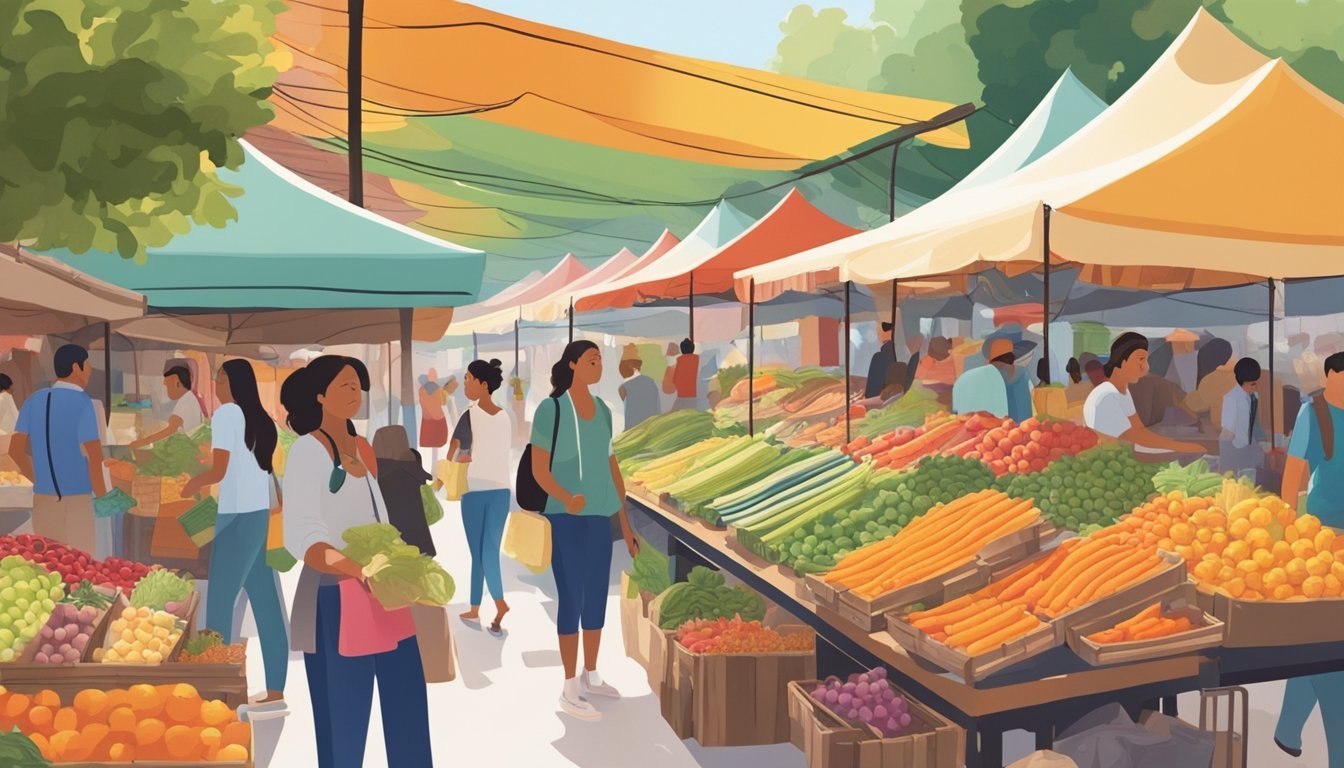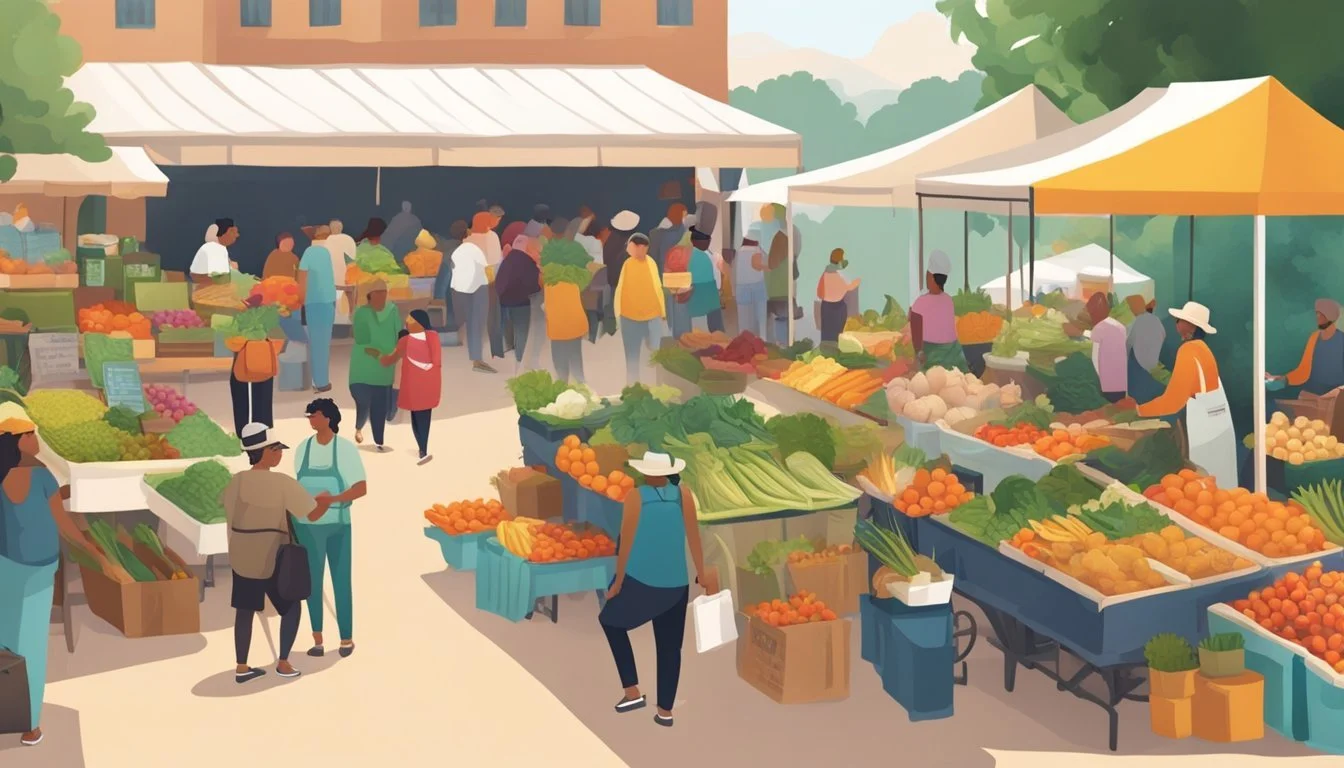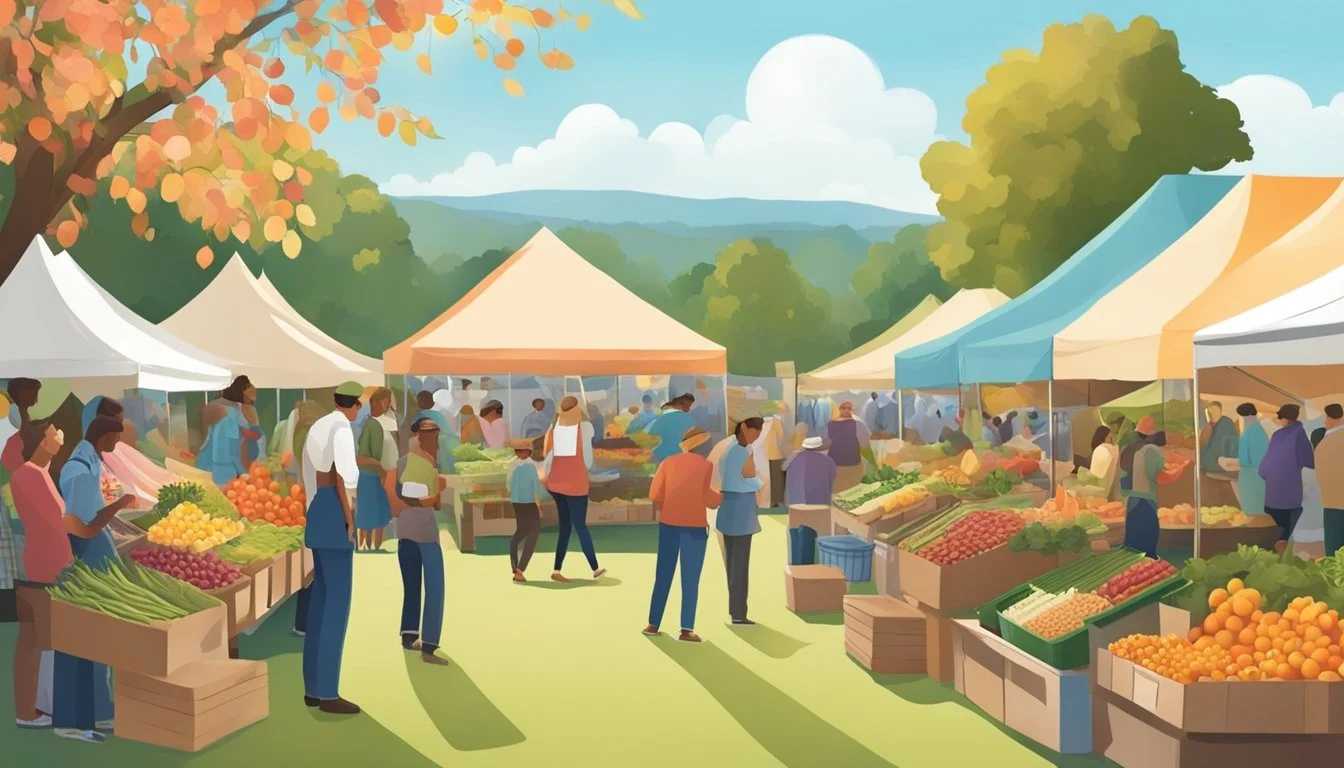A Guide to the Unique Finds at Farmers' Markets
Discovering Local Treasures
Farmers' markets serve as vibrant community hubs, uniting food lovers and local producers in a celebration of agricultural diversity and artisanal craftsmanship. These markets offer a unique shopping experience, providing access to an array of products that often cannot be found at standard grocery stores. Visitors can expect to find not only fresh, seasonal produce but also an assortment of small batch and niche items handcrafted by the farmers and artisans themselves.
Navigating a farmers' market can be an enriching experience, fostering a direct connection between consumers and the sources of their food. These markets play an essential role in supporting local economies and encouraging sustainable practices. Patrons are likely to encounter a variety of goods including heirloom vegetables, organic meats, handcrafted cheeses, and an impressive selection of gourmet condiments and preserves, each accompanied by a story that adds personal value to every purchase.
As farmers' markets continue to rise in popularity, they are increasingly recognized for the role they play in introducing the community to the plethora of unique and wild foods available. They facilitate a platform of education, where vendors share their knowledge and passion, allowing consumers to discover and appreciate the richness of local agricultural offerings. With an ever-changing roster of seasonal products and a constant influx of new vendors, each visit to a farmers' market promises a fresh and exciting shopping experience.
Exploring the Rich Variety of Produce
Farmers' markets are treasure troves of fresh, seasonal produce, providing an extensive variety of fruits and vegetables. They become a vital source for consumers to access organic and locally grown foods that offer superior nutrition and taste.
Seasonal Fruits and Vegetables
Farmers' markets excel in offering an assortment of seasonal fruits and vegetables that reflect the local growing calendar. Shoppers will find summer offerings such as juicy peaches and sweet melons, while fall brings a variety of squash and crisp apples. Citrus fruits typically make their appearance in the winter months, and spring welcomes tender greens and strawberries.
Spring: Strawberries, kale
Summer: Peaches, melons, tomatoes
Fall: Apples, squash
Winter: Citrus fruits
By focusing on seasonal produce, farmers' markets ensure that customers receive the freshest fruits and vegetables, packed with max nutrition.
Organic and Locally Grown Foods
The demand for organic and locally grown foods has grown, and farmers' markets have been pivotal in meeting this need. These markets often feature produce that is not only organic, reducing consumers' exposure to pesticides, but also grown by local farmers, ensuring a lower carbon footprint.
Locally Grown: Tomatoes, greens, corn
Organic Options: Kale, avocados
When customers purchase greens like kale or vibrant avocados, they are not just buying produce that is good for them but also supporting the sustainability of their local community. The robust flavors and nutritional benefits are immediately noticeable in freshly picked produce such as tomatoes and corn, staples of local agricultural efforts.
Specialty Foods and Artisanal Products
Farmers' markets are a treasure trove for those who appreciate the quality and richness of specialty foods and artisanal products. Vendors often showcase their mastery through unique cheese varieties, handcrafted sauces, and distinctive gourmet sweeteners.
Cheese and Dairy Delights
Artisanal cheese stands are a highlight, with offerings that range from soft, creamy bries to sharp, aged cheddars. Specialty dairy products, like hand-crafted butter and yogurt, often feature ingredients from local farms, ensuring freshness and flavor that mass-produced items can't match. Small-batch production often results in extraordinary taste and texture, delighting cheese connoisseurs with:
Hard Cheeses: Aged gouda, manchego, parmesan.
Soft Cheeses: Goat cheese logs, triple-cream brie.
Fresh Dairy: Cultured butter, cream-top yogurt.
Handcrafted Sauces and Condiments
Shelves sparkle with jars of small-batch sauces and condiments, each with a unique profile to elevate any dish. Artisans take pride in their crafted products, innovating with local ingredients and time-honored methods. Customers can find a variety of flavors and styles such as:
Tomato-based Sauces: (What wine goes well with tomato-based sauces?) Heirloom pasta sauce, spicy salsa.
Fruit-based Condiments: Fig jam, apple butter.
Vinegar and Oils: Aged balsamic, cold-pressed olive oil.
Gourmet Honey and Sweeteners
Honey vendors often offer a range of floral notes depending on where bees have foraged, from wildflower to orange blossom honey, adding a natural sweetness unmatched by commercial alternatives. Other sweeteners created with care can also be discovered, each with subtle flavors and rich histories:
Honey Varietals: Clover, wildflower, orange blossom honey.
Syrups and Nectars: Maple syrup, agave nectar.
Shoppers engaged with these artisanal offerings can directly connect with the individuals behind the products, gaining insight into the passion and process that goes into each small-batch good.
Botanicals and Plant-Based Offerings
Farmers' markets offer an array of botanical and plant-based products that cater to culinary, aromatic, and aesthetic needs. From fresh herbs (how long do fresh herbs last?) that enhance culinary creations to the vibrant beauty of flowers and plants, these markets are a treasure trove for unique finds.
Aromatic Herbs and Spice Blends
Vendors often present a selection of fresh herbs like basil, mint, and rosemary that are essential in many recipes. These herbs are not only flavorful but also a rich source of antioxidants. Spice blends created from dried herbs and local spices can elevate home cooking with complex flavors. Markets sometimes feature unique blends, sensitive to dietary and cultural preferences.
Herb Varieties: Basil, Mint, Rosemary, Thyme, Oregano
Purpose: Cooking, Teas, Natural Remedies
Floral Arrangements and Plants
The market can be a source for beautiful floral arrangements, including lavender, known for its soothing fragrance and potential benefits in stress relief. Flowers such as daisies, sunflowers, and a variety of seasonal blooms are often available, making for perfect natural decorations. Farmers' markets also cater to plant enthusiasts offering a selection of indoor and outdoor plants which can provide both aesthetic appeal and functional uses such as natural fiber production.
Floral Favorites: Lavender, Daisies, Sunflowers
Plants for Home and Garden: Succulents, Houseplants, Fiber-rich plants like hemp
Meat and Fresh Seafood Selections
Farmers' markets often showcase a variety of locally sourced meats and seafood. Shoppers can find high-quality, sustainable options that support local agriculture and fisheries.
Grass-fed Meats and Free-range Poultry
Farmers' markets are excellent places to find grass-fed meats such as beef and lamb, as well as free-range poultry. These products come from animals that have been raised in more natural, humane conditions compared to conventional farming practices. Consumers can benefit from meats that are typically richer in nutrients like omega-3 fatty acids, and from poultry that has been allowed to roam freely, contributing to a more robust flavor profile.
Beef: often grass-fed, resulting in leaner meat with a characteristic depth of flavor.
Lamb: grass-fed varieties are available, known for their distinct, gamey taste.
Chicken: free-range options boast tender meat and are popular for their versatility in recipes.
Fresh and Local Seafood Options
The freshness of seafood at a farmer's market can be unparalleled when compared to traditional retail outlets. Markets located near coastal areas often offer an array of fresh and local seafood, ranging from fish to shellfish. () These markets support local fishermen and provide seafood that has often been caught within a day or two, ensuring peak freshness and flavor.
Fish: Selections can include salmon, known for its pink, flavorful flesh, and hearty texture.
Shellfish: Options like shrimp and clams (how long do clams last?) are staples, perfect for anything from grilling to stews.
It's important for consumers to inquire about the origins of their seafood purchases to ensure they are making environmentally responsible choices.
The Farmers' Market Experience
Farmers' markets present a unique opportunity for consumers to connect with their food sources through direct interaction with local vendors and to partake in community-centered events. They offer an array of small-batch and seasonal products that are not typically found in traditional grocery stores.
Engaging with Local Vendors and Farmers
Shoppers at farmers' markets have the distinct advantage of engaging directly with the producers. Local vendors and farmers often enjoy discussing their products and sharing insights into their production methods. This interaction not only fosters transparency but also allows consumers to gain knowledge about the origin and quality of their purchases. Personal stories from the vendors add a touch of intimacy to each product, something distinct from the impersonal nature of mass-produced items.
Educational Conversations: Vendors at farmers' markets can provide consumers with cooking tips, recipe ideas, and advice on the best ways to store and prepare fresh produce.
Seasonal Selections: Farmers' markets are known for their seasonal offerings. Shoppers can find a variety of fruits and vegetables that are at the peak of their flavor and nutritional value.
Community Events and Activities
Farmers' markets often serve as community hubs, hosting events and activities that extend beyond shopping. They can include cooking demonstrations, tasting sessions, and live entertainment, all of which enhance the market experience. These activities not only provide enjoyment but also strengthen community bonds as local residents gather in a shared space to support their local economy.
Tastings and Demos: Interactive sessions like tastings or cooking demonstrations offer a hands-on approach to understanding and enjoying local produce.
Family-Friendly Environment: With activities often tailored for all ages, farmers' markets create a welcoming atmosphere that can be enjoyed by every member of the family.
Unique Finds and Novelty Items
Farmers' markets are the epitome of community and craft, offering a treasure trove of unique drinks and home-made products that stand out among common store-bought items.
Specialty Drinks and Beverages
At farmers' markets, one can discover an array of specialty drinks such as kombucha and artisan coffee. Kombucha, a fermented tea known for its tangy taste and probiotic benefits, usually comes in various flavors, showcasing a unique flavor profile with every batch. Coffee enthusiasts can enjoy small-batch roasts and blends, each offering a distinct aroma and taste that commercial coffees rarely match.
Kombucha: Known for its health properties and distinct tang.
Artisan Coffee: Offers a fresh experience far removed from generic supermarket brands.
Handmade Crafts and Specialty Wares
The personal touches of handmade crafts set farmers' markets apart. Shoppers may find hand-crafted sachets, filled with a mix of herbs and flowers, which serve as a natural way to freshen up spaces. The markets also often feature local artisans who create specialty wares, from pottery to jewelry. Another favorite find for many are the homemade salsas, available in a variety of flavors and spice levels, each made with locally sourced ingredients for an authentic taste.
Sachets: Herbal aroma carriers that naturally perfume the environment.
Homemade Salsas: A staple condiment with flavors ranging from mild to hot, catering to all taste preferences.
Tips for Navigating the Market
Visiting a farmers' market is an excellent opportunity to procure the freshest produce while supporting local farmers. To maximize the market experience, shoppers should consider timing and selection strategies for buying fruits and vegetables.
Best Times to Shop for Freshness
Early Morning: For the best selection of fresh fruits and vegetables, shopping early in the morning is key. Farmers are more likely to have a full stock of produce right when the market opens.
Weekdays: If the market is open on weekdays, these days may be less crowded, enabling a more relaxed shopping experience and high-quality interactions with farmers.
How to Select the Best Produce
Visual Inspection: The best produce often has a vibrant color and firm texture. Shoppers should look for fruits and vegetables that are free from unusual blemishes or soft spots.
Ask Questions: Engaging with farmers can yield information on the peak season for each type of produce, as well as tips for selecting the best pieces. Farmers can also provide details on the methods used to grow their fruits and vegetables.
Supporting Local Agriculture
When consumers purchase directly from producers at farmers' markets across the United States, they engage in a transaction that extends far beyond the exchange of goods for money. They actively participate in a movement that strengthens local food systems and fosters community well-being.
Benefits of Supporting Local Farmers
Local farmers cultivate a diverse range of products that are often fresher and more unique than those available in larger commercial outlets. They provide fresh foods that can lead to a more nutritious and diverse diet for the community. Locally grown produce doesn't need to travel long distances, which means it can be sold at peak freshness, packed with flavor and nutrients. Additionally, attaining food from local sources can help preserve genetic diversity in crops, as local farmers are more likely to grow a wider variety of species than larger commercial farms.
Freshness: Locally grown produce can be sold shortly after harvest.
Nutrition: Reduced time between harvest and consumption maintains higher nutritional content.
Diversity: Local farmers often cultivate a broader range of crop varieties.
Impact on the Local Economy and Environment
Investing in local agriculture keeps dollars circulating within the community, bolstering the local economy. This supports small and mid-sized farmers and creates jobs throughout rural and urban regions of the United States. An emphatic connection exists between the health of local agriculture and the economic vitality of the community; by supporting these markets, money is reinvested locally, contributing to economic diversification and growth.
On the environmental side, shorter transport distances for food mean reduced carbon emissions and a smaller carbon footprint. Sustainable agricultural practices, often observed by small-scale farmers, support biodiversity and can lead to healthier soil and reduced chemical use.
Economic Resilience: Money spent locally fuels the U.S. economy from within.
Job Creation: Small and mid-sized farm operations provide employment opportunities.
Environmental Stewardship: Reduced transport contributes to lower carbon emissions.
Farmers' Markets Throughout the Seasons
Farmers' markets adapt with the changing seasons, offering an assortment of produce and themed markets that capture the essence of each month. They serve as platforms for local farmers to showcase their seasonal harvests and for consumers to experience the freshest products.
Seasonal Offerings and Harvests
Fall: As the leaves turn, farmers' markets are abundant with fall harvests. Consumers can expect a variety of squash, pumpkins, and root vegetables. Apples and pears also reach peak ripeness, making them a staple in the fall markets. Each month signals a slight change in offerings, allowing for a diverse selection of fresh produce that is reflective of the local growers’ current harvests.
Monthly Offerings:
September: Look for late summer vegetables alongside early fall favorites such as various types of squash and the last of the season’s berries.
October: This month is rich with pumpkins, gourds, and various types of apples, perfect for autumn recipes.
November: Root vegetables like beets, carrots, and turnips become prevalent, providing hearty ingredients just in time for warming meals.
Monthly and Specialty Themed Markets
Many farmers' markets expand their traditional offerings by hosting special monthly or seasonal events. These can include:
Monthly Boxes: Some farmers' markets or associated vendors curate subscription boxes that correspond with each month's harvest, delivering a taste of the market direct to doorsteps. These boxes may include a variety of products from across the United States and sometimes pair fresh finds with stories of the products and profiles of the farmers.
Specialty Themed Markets: Based on the time of year, themes can range from organic-focused selections to holiday markets featuring crafted gifts and seasonal delicacies. Each themed market provides a unique experience while promoting local culture and the season’s best offerings.
Connecting with Food and Culture
Farmers' markets serve as a hub where the culture of a community and the joy of food come to life. They provide unique experiences where one can witness firsthand the intersection of local culinary practices and the shared pleasure of eating.
Food Trucks and Live Cooking Demonstrations
Farmers' markets often feature food trucks and live cooking demonstrations that showcase the talent of local chefs. These chefs harness the freshness of ingredients like pears, apples, and olives, transforming them into culinary masterpieces on the spot. Visitors not only taste the food but also learn about preparation techniques, elevating their culinary knowledge and skills.
Food Trucks: Patrons enjoy a variety of cuisines, often including fusion dishes that blend traditional recipes with modern twists.
Live Demonstrations: Chefs may pick seasonal produce like cranberries and apples directly from market stalls, demonstrating how to incorporate them into both classic and innovative dishes.
Local Culinary Influences and Traditions
The food offered at farmers' markets provides insight into the local culture and culinary traditions. Whether it's hand-crafted olive oil, artisanal cheeses, or heirloom fruit varieties, each item reflects the region's agricultural heritage. Visitors have the opportunity to chat with friends or make new ones while exploring stalls brimming with local flavors.
Local Produce: Seasonal fruits such as pears and apples are not just food items; they're part of the cultural identity and are celebrated through local dishes.
Cultural Exchange: The market becomes a lively space where stories are shared, and friendships flourish amidst discussions about food origins and preparation methods.







